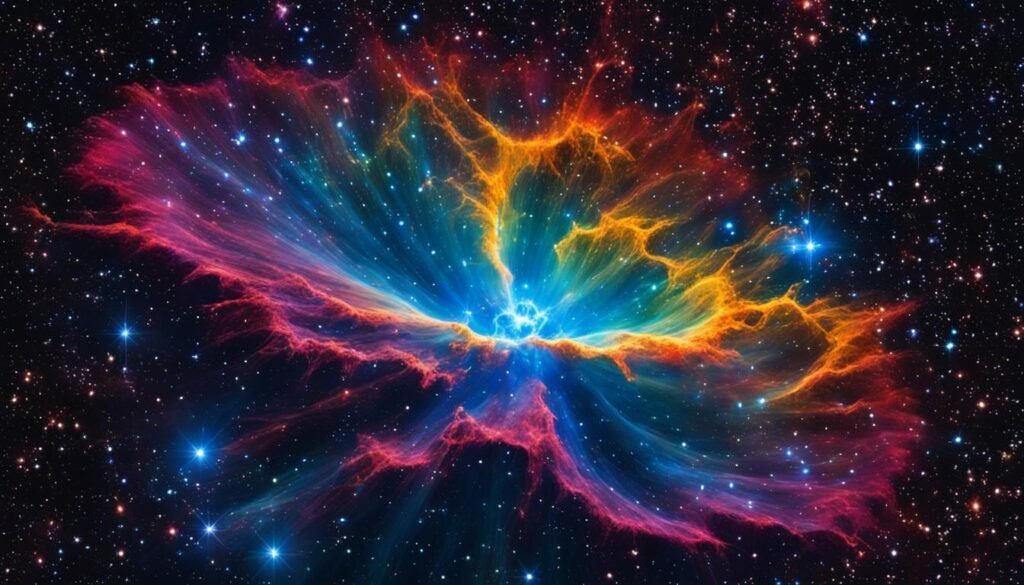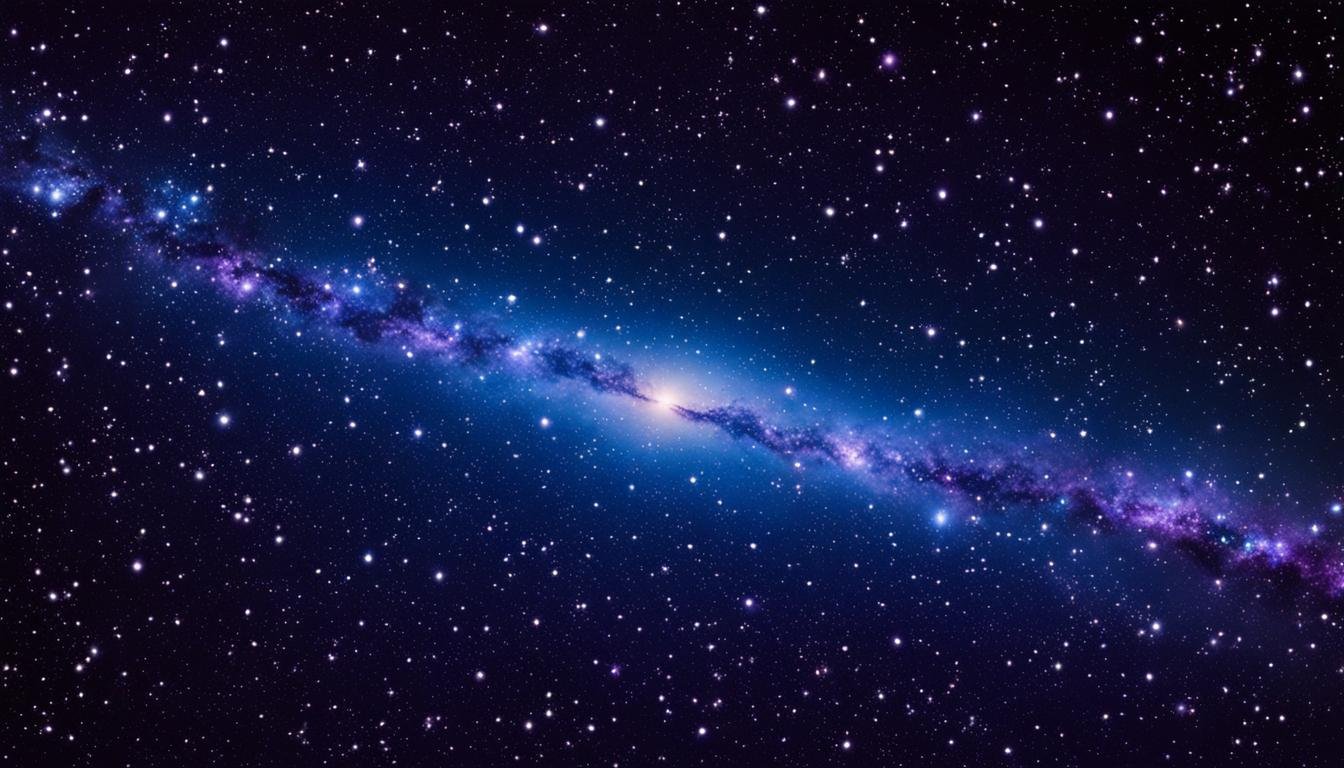| Genitive | |
| Abbreviation | |
| Pronunciation | |
| Main Stars | |
| Brightest Star | |
| Right Ascension | |
| Declination | |
| Sq. Deg. Area | |
| Crosses Meridian | |
| Visible Lat. Range |
Embark on a celestial voyage and set sail through the stars with the Vela constellation, a tapestry of the night that beckons star gazers and cosmic enthusiasts alike. Anchored in the southern skies, this constellation unfolds a narrative woven from the fabric of the universe itself. Once part of a more extensive mythological figure, the Vela constellation has charted its course to become a fascinating celestial entity on its own. As you dive into the Vela star cluster, prepare to encounter a realm replete with celestial wonders, each star narrating a tale as ancient as the cosmos.
Known for its historical and astronomical significance, the Vela constellation stands as a remnant of the colossal Argo Navis—symbolizing the grand ship of the fabled Argonauts. Your exploration of the constellations is not simply about the stars you can see but also about the rich histories and stories they represent. Each point of light in Constellation Vela is a crossroad of myth and science, offering a stellar experience like no other.
Key Takeaways
- Uncover the historical significance of the Vela constellation, once a part of the mythological Argo Navis.
- Discover the diverse and alluring celestial wonders housed within the Vela star cluster.
- Learn about the constellation’s division by astronomer Nicolas Louis de Lacaille in the 1750s.
- Appreciate the Vela constellation’s role in both astronomy and ancient Greek mythology.
- Prepare for a celestial journey through the stars, understanding the constellation’s unique place in the night sky.
Exploring the Sails of the Ship: Vela Constellation’s Rich History
Embarking on a journey into the night sky, your quest to understand the Vela constellation history unveils a saga that extends back to the earliest observations of the cosmos. The secrets of the night sky are vast, and the Vela galaxy, a celestial tapestry rich with lore, presents an astonishing chapter in the story of human astronomy.
A Voyage Through the Cosmos: Vela’s Connection to Argo Navis
The Vela constellation, once part of the colossal Argo Navis constellation, represents the sails of the mythological ship that carried Jason and the Argonauts. What once was a singular entity among the stars, Argo Navis was so immense that its breadth and majesty could only be transcended by its division into smaller, navigable constellations. The story of Vela is an odyssey that honors our celestial heritage, linking sky to myth in an everlasting bond.
Deciphering the Stars: Nicolas Louis de Lacaille’s Contribution
It was the astute mind of Nicolas Louis de Lacaille that forever changed how we perceive this celestial formation. Lacaille, with his methodical survey of the sky, split Argo Navis into the distinct constellations of Vela, Carina, and Puppis. His dedication to clarity in the night sky allowed this change to take place without losing the stellar connection to their ancient roots.
Cataloguing the Heavens: Vela’s Place in Ptolemy’s Legacy
Claudius Ptolemy’s influence on the Vela constellation history cannot be overstated. His early recordings of the stars mapped out a vision of the heavens that would endure through the ages. Even though Ptolemy could not foresee Lacaille’s eventual division, his works laid the groundwork for understanding the intricate dances of celestial bodies we continue to observe in the Vela galaxy.
| Event | Astronomer | Contribution to Vela Constellation |
|---|---|---|
| Ancient Cataloguing | Claudius Ptolemy | Recorded Argo Navis as a single constellation |
| 18th Century Revision | Nicolas Louis de Lacaille | Divided Argo Navis into three constellations including Vela |
| Modern Understanding | Astronomers Worldwide | Further research and expansion of knowledge on the Vela constellation |
As you gaze up at the stars, consider the rich tapestry of history that has been woven to bring understanding to these celestial sails. From the tales spun by ancient civilizations, charted meticulously by Claudius Ptolemy, to the refined celestial maps of Nicolas Louis de Lacaille, your experience of the Vela constellation is deeply rooted in a rich historical narrative.
Guiding Stars: Navigating Vela Constellation’s Stellar Bodies
Within the tapestry of the night sky, the Vela constellation stars serve as a celestial compass, guiding observers through the cosmos with their distinct brilliance. Among these, certain stars stand out, each with their fascinating characteristics and cosmic phenomena. Let’s embark on a stellar journey to uncover the mysteries of some of the most prominent stars of the Vela constellation.
Gamma Velorum: An Exceptional Multiple Star System
Gamma Velorum, often referred to as Regor, is not just an ordinary star but a remarkable multiple star system that is a beacon within the Vela constellation. Comprising several stellar components, it is anchored by a hot, blue supergiant and a rare Wolf-Rayet star, each one contributing to the system’s uniqueness and astronomical importance.
Alsephina – The Eclipsing Binary of Delta Velorum
Known as Alsephina, Delta Velorum reveals its nature as a dazzling eclipsing binary system. This dual star system offers a spectacular view as one star passes in front of the other, showcasing the dynamic and rhythmic celestial dance that exemplifies the beauty of the Vela constellation stars.
Unveiling Suhail – The Radiant Lambda Velorum
The star Suhail, or Lambda Velorum, captures the observer’s gaze with its steady, orange glow. As a distinct beacon among the Vela constellation stars, Suhail is an orange giant whose brightness varies, offering a glittering spectacle against the canvas of space.
| Star Name | Designation | Type | Notable Features |
|---|---|---|---|
| Gamma Velorum | γ Velorum | Multiple Star System | Hot blue supergiant, Wolf-Rayet star |
| Alsephina | δ Velorum | Eclipsing Binary System | Varied brightness, illustrative stellar dance |
| Suhail | λ Velorum | Orange Giant | Variable brightness, prominent luminosity |
As navigators once used the stars to traverse Earth’s oceans, today you can embark on a cosmic voyage with the Vela constellation stars as your guides. From the complex Gamma Velorum multiple star system to the rhythm of Alsephina‘s dance and the consistent glow from Suhail, there is much to explore and appreciate in this remarkable celestial gathering.
Hidden Wonders: Deep Sky Objects Within Constellation Vela
As you explore the expanse of the cosmos, the constellation Vela serves as a doorway to some of the most spellbinding deep sky objects. Journey through Vela’s rich celestial landscape, and you’ll encounter nebulae, supernova remnants, and star clusters that are as intriguing as they are beautiful. Be prepared to discover the wonders that lie beyond our solar system.

NGC 3132: The Enchanting ‘Eight-Burst Nebula’
On the border of Vela and Antlia, NGC 3132, known poetically as the ‘Eight-Burst Nebula’, presents itself as a celestial tapestry. This planetary nebula’s unique structure and nebulous glow provide a splendid view that keeps astronomers and stargazers alike captivated by its charm. It stands as one of the most photogenic Vela nebula formations in our galaxy.
The Cosmic Aftermath: The Vela Supernova Remnant
In the aftermath of a star’s cataclysmic collapse, the Vela Supernova Remnant offers a glimpse into the final stages of a star’s lifecycle. What you’re witnessing is the vestige of a supernova explosion, home to the Vela Pulsar—a rapidly spinning neutron star that marks the heart of this fascinating remnant—a testament to the incredible forces at play in the universe.
A Skyward Gaze: The Omicron Velorum Cluster
The Omicron Velorum Cluster, also referenced as IC 2391, is an open-star cluster that further cements Vela’s standing as a haven for deep sky watchers. This vibrant cluster, a relatively close-neighboring conglomeration of stars, offers a unique opportunity for study and appreciation of the developmental stages of stellar bodies within the boundless cosmos surrounding us.
Amongst the vibrant stars of constellation Vela, these deep sky objects—from the echoes of past supernovae to glowing nebulae and bustling star clusters—invite you to peer deeper into the universe. Each of these cosmic entities, namely the Vela Supernova Remnant, NGC 3132, and the Omicron Velorum Cluster, are not only a feast for the eyes but also fodder for the imagination, igniting a passion for unraveling the mysteries of far-flung galaxies and ethereal deep sky objects.
Myth Meets Sky: Stories Woven into the Vela Constellation
As you gaze up at the starry expanse, you are not just looking at points of light, but at stories etched in the heavens. The Vela constellation myths stand as a testament to the human penchant for weaving tales that transcend time and space, particularly the legendary Argo Navis myth. Drawing from the famed narrative of Jason and the Argonauts, the section of the sky where Vela resides carries the enduring echo of their mythical voyage.
Despite Vela’s seemingly silent stars, they are chorusing a tribute to the grandeur of Greek mythology. Scholars and enthusiasts alike explore constellation stories, piecing together the saga that once celebrated heroes, gods, and celestial craftsmanship. The Vela Constellation, with sails unfurled across the night sky, honors the ship Argo—of which Argo Navis was its mythological representation, a vessel so pivotal to the Argonauts’ quest for the Golden Fleece. Let’s delve into this celestial narrative and unwrap the fabric of myths that adorn these cosmic sails.

| Constellation | Mythological Significance | Representative Star |
|---|---|---|
| Vela (The Sails) | Represents the sails of Argo Navis, the ship that carried Jason and the Argonauts | Suhail, symbolizing the guiding light for the sailors |
| Carina (The Keel) | The keel of the ship, fundamental in keeping it stable and balanced in the treacherous seas | Canopus, the second-brightest star in the night sky, standing for the ship’s enduring might |
| Puppis (The Stern) | The stern from which the ship was navigated, steering the Argonauts towards their fabled destiny | Naos, the beacon that steers the cosmic vessel |
Each star within the constellation holds more than just heat and light; they hold stories that have inspired civilizations. As you partake in the age-old tradition of stargazing, let the Vela constellation serve not only as a source of celestial wonder but also as a bridge to the past where myth meets sky.
Constellation Vela: Stargazing Guide and Intriguing Facts
The Vela constellation is akin to a beacon in the celestial sea, guiding observers through the wonders of the southern hemisphere’s night sky. Whether you’re an amateur astronomer or simply enjoy the occasional starlit spectacle, knowing when and where to look is key to unlocking the visual treasures of Vela.
Location and Visibility: When to See Vela in the Night Sky
You have the best chance of spotting the vibrant Vela sails in March, when they are prominently displayed in their full glory. Covering an expansive area of the sky, you can witness this constellation’s radiant display from a broad range of latitudes. Utilize the Vela constellations map as your personal navigational tool, and stand ready to be captivated by the stars that have both historically and astronomically enriched our understanding of the universe.
Mapping the Sails: The Vela Constellations Map and Its Stars
Arming yourself with a stargazing guide featuring the Vela constellation can significantly enhance your skywatching experience. As you trace the intricate pattern laid out before you, stars such as Regor and Markeb become familiar landmarks on your celestial journey. Each star contributing to Vela’s outline serves as a luminous piece of the greater galactic puzzle, awaiting your discovery.
Luminosity and Legacy: The Brightest Points in Vela
Delve into Vela constellation facts and you’ll find that its legacy is written in the light of the brightest stars that form it. Notable among them is Gamma Velorum, a complex star system that’s also the closest known brown dwarf system. As you embark on your stargazing journey, let the luminosity of Vela’s stars guide you through the rich history and fascinating science of star observation.
FAQ
What is the Vela constellation and where did its name originate?
The Vela constellation, meaning “the sails” in Latin, is a group of stars located in the southern hemisphere, named for its representation of the sails of the mythological ship, Argo Navis. Its origins date back to ancient Greek mythology, and it stands out today as an independent constellation following its division by Nicolas Louis de Lacaille in the 18th century.
Who was Nicolas Louis de Lacaille and what was his contribution to the Vela constellation?
Nicolas Louis de Lacaille was an 18th-century French astronomer renowned for his work in the southern hemisphere. His significant contribution to the Vela constellation was the division of the large Argo Navis constellation into smaller, more manageable constellations. This included Vela, which Lacaille defined as representing the sails of the ship.
What is the historical importance of the Vela constellation in Ptolemy’s legacy?
The Vela constellation was historically catalogued by the 2nd-century astronomer Claudius Ptolemy as part of the giant Argo Navis constellation. Its placement in Ptolemy’s Almagest solidified its significance in astronomy, contributing to our understanding of the constellations that make up our night sky.
Can you tell me more about Gamma Velorum?
Gamma Velorum is an exceptional star within the Vela constellation, notable as a complex multiple star system. It consists of two primary components: one being a hot blue supergiant and the other a rare Wolf-Rayet star, making it a remarkable point of interest for astronomers and star enthusiasts alike.
What can stargazers observe in the deep sky areas of the Vela constellation?
Stargazers exploring the Vela constellation can observe several deep sky objects, including the beautiful ‘Eight-Burst Nebula’ (NGC 3132), the awe-inspiring Vela Supernova Remnant, and the intriguing Omicron Velorum Cluster (IC 2391), which provides a broad array of cosmic phenomena.
What myths are associated with the Vela constellation?
While Vela itself isn’t directly linked to a specific mythological story, it forms a part of the ancient Greek constellation Argo Navis, representing the ship that carried Jason and the Argonauts. The sails of Vela are a silent tribute to these maritime legends and the constellation carries the mythological legacy of its larger progenitor.
When and where can the Vela constellation be best observed?
The Vela constellation is best observed during the month of March, in the night sky. Sited in the southern hemisphere, it is visible from latitudes between +30° and -90°. Aiding tools such as a Vela constellations map can help pinpoint its position and main stars for amateur and seasoned stargazers alike.
What are the brightest stars in the Vela constellation?
Some of the brightest stars in the Vela constellation include Regor (Gamma Velorum), Markeb (Kappa Velorum), and Suhail (Lambda Velorum). Each of these stars adds a unique shine to the constellation, contributing to its overall luminosity and the fascinating story it tells in our night sky.






